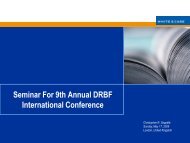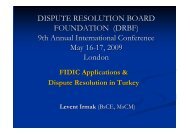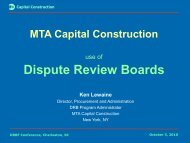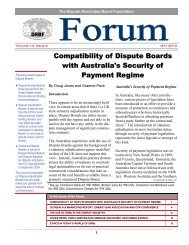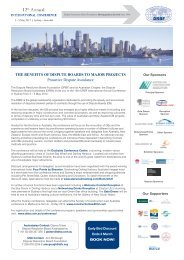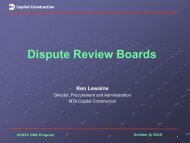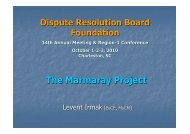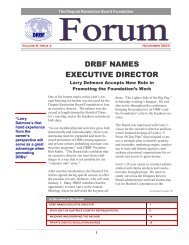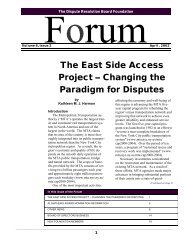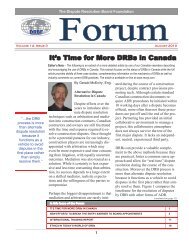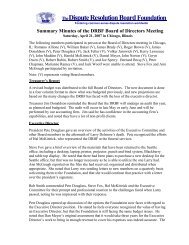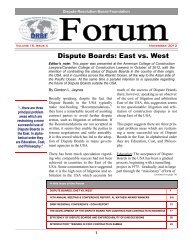DRBs Down Under - Dispute Resolution Board Foundation
DRBs Down Under - Dispute Resolution Board Foundation
DRBs Down Under - Dispute Resolution Board Foundation
Create successful ePaper yourself
Turn your PDF publications into a flip-book with our unique Google optimized e-Paper software.
<strong>Foundation</strong> Forum<br />
tures of the DRB/DAB process they wish to implement<br />
on particular projects where they have the choice<br />
to do so.<br />
Commentary<br />
1. Do both systems assist the parties in avoiding<br />
disputes or resolving them before they become<br />
formal claims subject to the DRB/DAB<br />
A DRB, in practice, encourages the parties to try to<br />
resolve disputes before they become claims. Sometimes<br />
DRB specifications or operating procedures will<br />
mention this role, but there is no formal requirement<br />
for the DRB to facilitate resolution of a dispute or of a<br />
formal claim referred to the DRB. Many DRB specifications<br />
do, however, provide for what is commonly<br />
referred to as an “advisory opinion”, with the DRB<br />
serving as an informal “sounding board” for the parties<br />
before submission of a formal claim to the DRB.<br />
The DAB approach contemplates more explicitly that<br />
the parties should negotiate and try to reach agreement<br />
before they refer the matter to the DAB. Indeed under<br />
FIDIC SC 3.5 the Engineer is obliged “to consult with<br />
each party in an endeavour to reach agreement” between<br />
them, before he issues his own determination,<br />
which normally are all stages that precede the referral<br />
to a DAB. It is also noteworthy to compare the Red<br />
Book with the MDB Harmonised edition (i.e., the Red<br />
Book as adapted to meet the requirements of the Multilateral<br />
Development Banks including The World<br />
Bank) where the MDBs introduced a supplementary<br />
sentence into the DAB’s procedures 4 to give the DAB<br />
an express role in dispute avoidance. 5 Moreover, the<br />
parties may still reach an amicable settlement before or<br />
after lodging an objection to the DAB decision.<br />
The interesting point in FIDIC SC 3.5 is that in this<br />
clause the Engineer takes on a different duty – to act<br />
fairly (and, implicitly, impartially). 6 In all other respects<br />
the Engineer acts for the Employer (SC 3.1).<br />
Although there has been much discussion about the<br />
Engineer’s duty to consult with each party in an endeavour<br />
to reach agreement often, in practice, this is<br />
overlooked. The authors suggest that there needs to be<br />
more focus on the need for Engineers to carry out this<br />
role in international contracts. That said, this role is<br />
bound to be somewhat restricted since the Engineer is<br />
unlikely to broker an agreement that involves an acceptance<br />
of its own failure such as a design deficiency<br />
or delay in issuance of information.<br />
Like the DRB, the DAB can also be asked jointly by<br />
the parties to provide an informal opinion before the<br />
Engineer issues a formal ruling – this gives the parties<br />
a good indication of which way the <strong>Board</strong> is likely to<br />
determine the issue if a formal claim is referred. So,<br />
both <strong>DRBs</strong> and DABs provide the parties multiple opportunities<br />
to avoid a formal claim, but the DAB contemplates<br />
a more active role for the Engineer, at least<br />
before a formal claim is referred to the DRB.<br />
2. Do both systems assist the parties in resolving<br />
claims before they migrate to other, more formal,<br />
legal processes<br />
The DRB issues a non-binding recommendation that<br />
the parties can accept, reject or use as the basis for negotiations.<br />
An argument can be made that there is<br />
benefit to the parties in maintaining, at the project<br />
level, ultimate control over the outcome of the claim.<br />
This permits the parties to take into account commercial<br />
and other considerations and make a business<br />
judgment whether a resolution is in the best interests<br />
of the parties and the project. This also helps preserve<br />
relationships because the outcome is agreed to by the<br />
parties.<br />
In contrast, a DAB issues a decision that the parties are<br />
bound to follow, subject to lodging an objection for a<br />
later “appeal” through arbitration (where agreed) or<br />
litigation. This could be said to be divisive since one<br />
party wins and one loses, but in practice it brings clarity<br />
and resolution to the dispute, since the dispute has<br />
been adjudicated on by a <strong>Board</strong> of experts whose opinion<br />
is respected. Even where a party has served a Notice<br />
of Dissatisfaction, the parties are obliged to try<br />
and settle the difference amicably – so there is indeed<br />
a further chance to reach a consensus. Indeed, it is<br />
not uncommon for both parties to serve such Notices<br />
and then agree to revised settlement terms.<br />
It is also noteworthy that in the absence of a Notice of<br />
Dissatisfaction being served within 28 days of receipt<br />
of the decision, the DAB decision becomes final and<br />
4 Procedural Rules Annex, paragraph 2.<br />
5 ICC DB Rules expressly provide that a DAB may meet with only one party while providing Informal Assistance, with the agreement of both<br />
parties.<br />
6 Also the Engineer has a duty to act fairly in the certification of payment.<br />
———————————————————————————————————————————————————<br />
20




